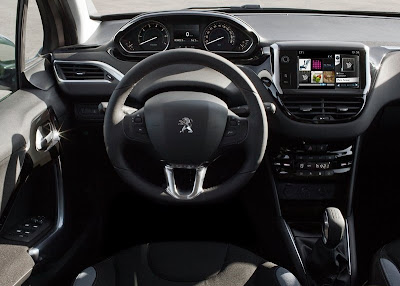CAR GARAGE | Peugeot 208 (2013) | The reduced front overhang (- 6 cm compared with the 207) and the shorter rear overhang (- 1 cm), along with the reduced weight of the vehicle, directly benefit improved proportions, agility and everyday practicality (parking, maneuvers, etc.). To Obtain a maximum reduction in the weight of the vehicle, a true "hunt to Eliminate excess weight" took place at the same time to create, overall, a "virtuous spiral", favoring fuel consumption, passive safety and the dynamic performance of the vehicle. Each component is designed, each technique used, each part of the vehicle, etc.
Considered has been with this in mind, by every member of the project team working on the vehicle: front aluminum beam-absorber, size of the front sub frame, laser welding of the roof, extensive use of VHSS and UHSS (Very High Strength Steel and Ultra High Strength Steel) panels, soundproofing of the engine at source, etc. Finally, the Peugeot 208 weighs 110 kg less than the 207 with the same 1.4L HDi engine, up to 173 kg less with the entry level petrol engine of comparable power: in short, a feat the which allows the Peugeot 208 to start from a weight of 975 kg!
The Peugeot 208 benefits from a high level of primary safety, through its road-holding and design ("head-up instrument panel", as standard ESP, cruise control / speed limiter on many versions ...). Here again, the safety benefits fully from the limiting of the overall weight of the vehicle. The Peugeot 208 is fitted with effective restraining devices: two bags of water front, 2 front side air bags, two bags of water curtain, two ISOFIX anchorage points with 3 locations in the rear. The Peugeot 208 also benefits from the Marque's leadership in terms of tertiary safety by offering, as on most vehicles in the range, a system the which offers the Peugeot and Peugeot Connect Connect SOS Assistance services free of charge and with no time limit.
A new stage in the Group's downsizing strategy, this new generation of engine block permits a true breakthrough in terms of fuel consumption and CO2 emissions, while offering a good level of performance for the "entry-level" versions. The efficiency of the HDi diesel engines PEF and the VTi and THP petrol engines, reinforced by the arrival of a new generation of 3-cylinder petrol engines, in fact contributes to the reduction of 34 g / km in the average emissions of CO2 of the Peugeot 208 range compared with the launch of the 207 range, and a difference of up to 46 g for the entry-level petrol engine.










